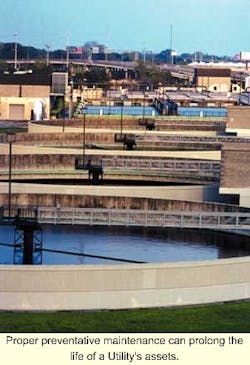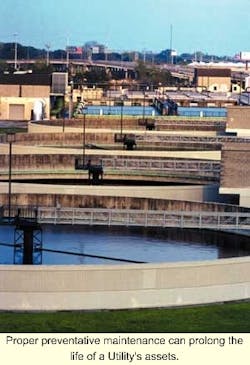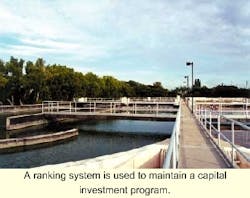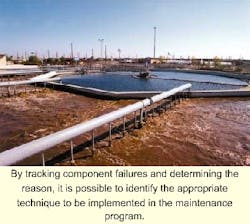Contract Operators Turn to Asset Management
By Ivan Burrowes and Tracy Favre
To suggest that contract outsourcing of operation and maintenance can prolong the life of municipal or industrial assets would, in some arenas, be scoffed at. However, an increasing number of cities and industrial sites are turning to contractors to operate and maintain their assets. They are taking such steps to reduce their operating costs and to enhance the life of their utility service plant and equipment.
Contract operators typically are obligated to meet all applicable regulations and requirements set by the client. These requirements can include meeting water quality, environmental, health, safety and maintenance standards. The reputation of the contracting company is dependent on how it performs. Allegations of poor performance will travel 10 times faster and further than news of good performance. Consequently, for a reputable company to stay in business it must deliver the expected service, day in and day out.
Contract Language Is Key
The expectations and obligations of both the client and the contractor should be spelled out clearly in the contract language of the agreement. The language used in the contract will determine the level of maintenance that is expected/required for contract compliance. It is important to realize that the contract must be a win-win situation for long-term success.
In some cases, contract language may actually offer a disincentive for good maintenance practices by penalizing the contractor, in the form of reduced profits, for upgrades of equipment or increased maintenance practices to correct poor conditions pre-existing the agreement. In cases where a facility historically has not received sufficient maintenance, and where the contractor solely bears the cost of expensive improvements, the contractor would have no incentive to make those improvements.
A better practice is to set reasonable limits on overall maintenance budgets with a "no-fault" or 100 percent reimbursement clause to correct a historical lack of equipment upgrades and maintenance oversights that took place prior to the execution of the agreement. The facility would be brought up to proper operating conditions, at the same time providing the contractor with strong incentive to keep the facility in excellent working order.
Prolonging Asset Life
Although O&M contractors may not own the assets, a contract with proper incentives motivates reputable contractors to regard the assets as their own. Such an approach invariably places them in the position of viewing the assets through the eyes of the owner, the client. With this view comes the need to ensure that the life of all assets is maximized in a cost-effective manner.
Asset management for the contractor starts before an asset is installed, not when it breaks down and emergency repairs or replacement is needed. Emergency repairs are costly and can present a significant risk to continuity of service and public health.
The first step for management of existing assets is to develop a complete and comprehensive asset register that includes all relevant operational procedures and maintenance requirements for each asset. In the case of new equipment or systems, all operational and maintenance training should take place before the asset is fully commissioned.
The manufacturer's planned and preventative maintenance frequencies should be listed and maintenance scheduled and undertaken accordingly. Breakdowns should be recorded and can lead to revision of the manufacturer's recommendations once the warranty period has passed.
By tracking component failures and determining the reason, operators can identify appropriate maintenance techniques. These techniques could include overhauling the component on a regular basis or, where applicable, undertaking condition monitoring using thermal imaging or vibration analysis to provide an early warning of the need for repair or replacement.
Although important to asset management, planned maintenance programs can become excessive and not cost effective. Periodically, operators should review their planned and preventative program task frequencies. The use of software tools can be helpful to quantify the relative impact of risk, safety, and performance costs of routine maintenance activities. Such an analysis can then be used to identify the optimum frequency of preventative maintenance to ensure that the life of the asset is prolonged in a cost-effective manner.
Investment Management
The "asset register" is key to an asset management plan. It provides the basis for scheduling maintenance and also for tracking the condition of assets. The plan determines the serviceability of the assets in terms of condition and performance.
When building an asset register, each asset can be ranked in terms of its physical condition. A typical ranking system might give assets a rank ranging from 1 to 5. Those assets that are new and in very good condition are ranked 1 while those in very poor condition with major structural issues would be ranked 5. A similar ranking can also be applied to performance, with those assets performing according to design specification or better being ranked 1 and those that are consistently failing to meet specifications ranked 5. In such a system, those assets ranked 1/1 would not need replacement, while those with a 5/5 ranking would be overdue for replacement.
The criticality test is then applied to ensure that non-essential assets are not being replaced but are shut down or scrapped. This ranking system is used to maintain a capital investment program.
Assets should be reviewed and ranked at least annually to keep the operator and owner fully informed of the facility investment needs. By having such an asset management plan, the contractor can ensure that all expectations and performance standards are met consistently and efficiently.
Conclusion
In addition to maintenance and production of investment programs, O&M contractors strive to realize the full process potential of all assets. When faced with plant expansion or the need to meet tighter standards, contractors will look at how a process can be modified within the existing facilities to minimize the capital investment required. This could include such actions as resolution of Infiltration And Inflow in a sewer system or conversion of an existing activated sludge plant to biological nutrient removal. The objective is to meet the new demands and standards but at the same time minimize the client's operating costs and capital investment.
About the authors:
Ivan Burrowes is a Senior Vice President with Severn Trent Environmental Services. He has 28 years experience in the water and wastewater industries including 17 years in operations and management positions performing contract O&M. Tracy Favre, P.E., is the Director of Marketing for Severn Trent Environmental Services. She has 14 years of experience in project development for wastewater systems.



